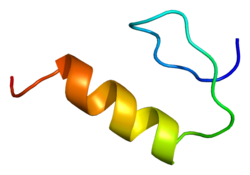Transcription factor Sp1
Protein-coding gene in the species Homo sapiens From Wikipedia, the free encyclopedia
Transcription factor Sp1, also known as specificity protein 1* is a protein that in humans is encoded by the SP1 gene.[5]
Function
The protein encoded by this gene is a zinc finger transcription factor that binds to GC-rich motifs of many promoters. The encoded protein is involved in many cellular processes, including cell differentiation, cell growth, apoptosis, immune responses, response to DNA damage, and chromatin remodeling. post-translational modifications such as phosphorylation, acetylation, O-GlcNAcylation, and proteolytic processing significantly affect the activity of this protein, which can be an activator or a repressor.[5]
In the SV40 virus, Sp1 binds to the GC boxes in the regulatory sequence of the genome.
Structure
SP1 belongs to the Sp/KLF family of transcription factors. The protein is 785 amino acids long, with a molecular weight of 81 kDa. The SP1 transcription factor contains two glutamine-rich activation domains at its N-terminus that are believed to be necessary for promoter trans-activation.[6] SP1 most notably contains three zinc finger protein motifs at its C-terminus, by which it binds directly to DNA and allows for interaction of the protein with other transcriptional regulators. Its zinc fingers are of the Cys2/His2 type and bind the consensus sequence 5'-(G/T)GGGCGG(G/A)(G/A)(C/T)-3' (GC box element). Some 12,000 SP-1 binding sites are found in the human genome.[7]
Applications
Sp1 has been used as a control protein to compare with when studying the increase or decrease of the aryl hydrocarbon receptor and/or the estrogen receptor, since it binds to both and generally remains at a relatively constant level.[8]
Recently, a putative promoter region in FTMT, and positive regulators {SP1, cAMP response element-binding protein (CREB), and Ying Yang 1 (YY1)] and negative regulators [GATA2, forkhead box protein A1 (FoxA1), and CCAAT enhancer-binding protein b (C/EBPb)] of FTMT transcription have been identified (Guaraldo et al, 2016).The effect of DFP on the DNA-binding activity of these regulators to the FTMT promoter was examined using chromatin immunoprecipitation (ChIP) assay. Among the regulators, only SP1 displayed significantly increased DNA- binding activity following DFP treatment in a dose-dependent manner. SP1 knockdown by siRNA abolished the DFP-induced increase in the mRNA levels of FTMT, indicating SP1-mediated regulation of FTMT expression in the presence of DFP. Treatment with Deferiprone increased the expression of cytoplasmic and nuclear SP1 with predominant localization in the nucleus.[9]
Inhibitors
Plicamycin, an antineoplastic antibiotic produced by Streptomyces plicatus, and Withaferin A, a steroidal lactone from Withania somnifera plant are known to inhibit Sp1 transcription factor.[10][11]
miR-375-5p microRNA significantly decreased expression of SP1 and YAP1 in colorectal cancer cells. SP1 and YAP1 mRNAs are direct targets of miR-375-5p.[12]
Interactions
Transcription factor Sp1 has been shown to interact with:
- AATF,[13]
- CEBPB,[14][15]
- COL1A1,[16]
- E2F1,[17][18][19]
- FOSL1,[20]
- GABPA,[21]
- HDAC1,[13][22][23][24]
- HDAC2,[23][24][25]
- HMGA1,[15]
- HCFC1,[26][27]
- HTT,[28]
- KLF6,[29]
- MEF2C,[30]
- MEF2D,[31]
- MSX1,[32]
- Myogenin,[33]
- POU2F1,[26][34]
- PPP1R13L,[35]
- PSMC5,[36][37]
- PML,[38]
- RELA,[39][40]
- SMAD3,[41][42]
- SUMO1,[36]
- SF1,[43]
- TAL1,[44]
- UBC.[36]
- WRN,[45]
- DDX3X
References
Further reading
External links
Wikiwand - on
Seamless Wikipedia browsing. On steroids.






